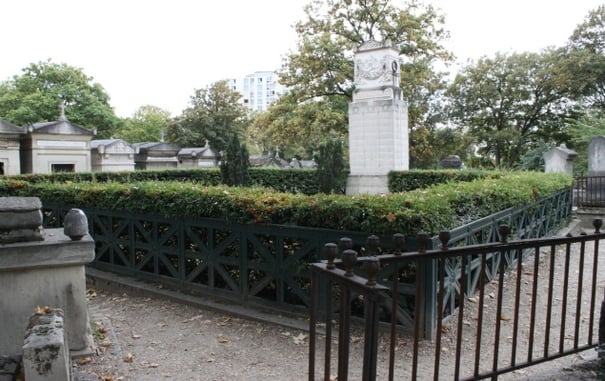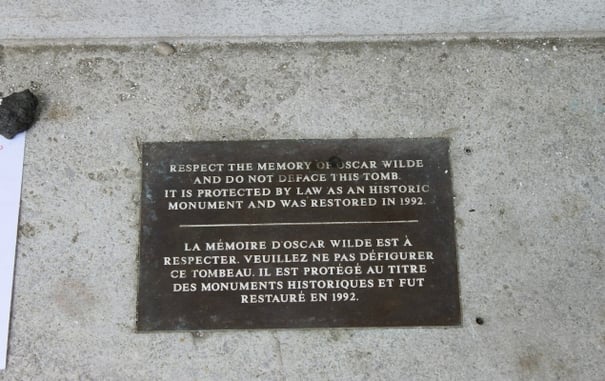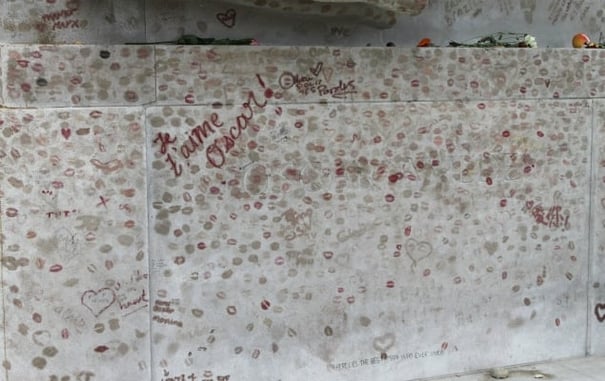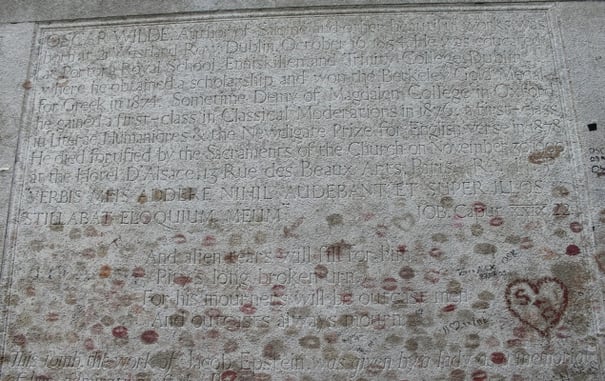Situated among the rolling hills of the 20th arrondissement in east Paris, Père Lachaise Cemetery is the hauntingly beautiful final resting place of many famous figures in art, music, literature and history. Visitors from around the world come to cemetery to walk along its quiet pathways and pay their respect to Jim Morrison, Oscar Wilde, Edith Piaf and Frédéric Chopin, just to name a few. Established in 1804 on what was then the outskirts of Paris, the cemetery stretches out over 110 acres and contains a myriad of different grave styles, ranging from simple headstones to elaborate mausoleums and burial chambers. Despite the melancholy setting, Père Lachaise feels more like an English garden than a cemetery, with its maze of tree-lined cobbled walkways providing tranquil respite from busy city life.

Visiting
Like most points of interest in Paris, the best way to reach Père Lachaise is by metro. Take the metro to Philippe Auguste (not Père Lachaise station). From here, the main entrance is just one block away. There are so many notable figures laid to rest at Père Lachaise that it would be impossible to list them all. Some of the most visited, however, include:
Abelard and Heloise
The popularity of Père Lachaise as a final resting place can largely be attributed to the graves of Abelard and Heloise. The star-crossed lovers are at the center of one of the most famous and tragic romances of the middle ages. Abelard was a well-respected French philosopher in the 12th century. A nobleman hired Abelard to tutor his niece Heloise, who was more than 20 years his junior. Abelard and Heloise fell in love, but were separated when Heloise’s uncle learned of the relationship. For the rest of their lives, the pair corresponded through beautiful love letters to one another, and while they were separated in life, their purported remains now lie next to one another at Père Lachaise.
Frédéric Chopin
Warsaw-born composer and piano virtuoso Frédéric Chopin spent most of his adult life in Paris. After he died in Place Vendôme, his body was buried at Père Lachaise and his heart was buried in his native Poland. Chopin’s white marble tomb is almost always adorned with colorful flowers and features a statue of Euterpe, the Greek muse of music, weeping over a broken instrument.
Édith Piaf
One of the most celebrated French singers of all time, Édith Piaf shot to worldwide fame in the mid 20th century with her songs “La Vie en rose” and “Non, je ne regrette rient”. Piaf passed away in 1963 and was buried in a family grave at Père Lachaise marked Familie Gassion - Piaf.
Oscar Wilde
Irish playwright and novelist Oscar Wilde died in Paris in 1900. His tomb is one of the most unique at the cemetery and features an angel with an elaborate headdress. The side of the tomb features a few lines from Wilde’s Ballad of Reading Gaol:
And alien tears will fill for him
Pity’s long-broken urn,
For his mourners will be outcast men,
And outcasts always mourn.
Jim Morrison
Jim Morrison, the lead singer of The Doors, died of a suspected drug overdose in Paris in 1971 at the age of just 27. His grave site at Père Lachaise was once marked by a stone bust in his image, but now features a simple flat stone with the inscription “according to his own daemon” in Greek.

History
With the inner city cemeteries of Paris largely full by the late 18th century, the city made a concerted effort to develop larger cemeteries on its outskirts. Père Lachaise Cemetery was opened under the instruction of Napoleon I in 1804. The site was named after Père François de la Chaise, who lived there in the 17th century and was the confessor of Louis XIV. When it initially opened no more than a few dozen people were laid to rest in Père Lachaise, as Parisians thought it was too far from the city.
In order to attract more interments, the remains of French poet Jean de La Fontaine and famous French playwright Molière were moved to the cemetery within a year of its opening. This helped raise the profile of Père Lachaise, but it still didn’t prove particularly popular. It wasn’t until Josephine Bonaparte had the remains of Abelard and Heloise moved to the Père Lachaise and buried together in 1817 that it really attracted any attention. With Abelard and Heloise entombed near its entrance, the number of interments grew from a few dozen to 33,000 within a few years.

Paris Perfect's Personal Tip
You can pick up a free map at the entrance of Père Lachaise that will lead you in the direction of some of the cemetery’s most famous graves. Keep this map handy - the paths inside the cemetery twist and turn in so many directions that it getting lost is not a difficult task!

Essential Information
- Address: 16 Rue du Repos, 75020 Paris, France
- Closest Metro: Philippe Auguste (closest to main entrance), Gambetta (closest to Oscar Wilde’s tomb), Père Lachaise
- Website: http://www.pere-lachaise.com/perelachaise.php?lang=en
- Opening Times:
November to mid-March: Weekdays 8.00am to 5.30pm, Saturdays and holidays 8.30am to 5.30pm, Sundays 9.00am to 5.30pm.
Mid-March to October: Weekdays 8.00 to 6.00pm, Saturdays 8.30am to 6.00pm, Sundays and holidays 9.00am to 6.00pm.
Sign up for our Vacation Perfect newsletter and real estate updates.
